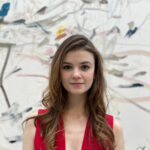Trailblazer Merritt Moore on Her Dual Career as Dancer and Physicist
“I’m quitting dance.” Freelance dancer Merritt Moore has said this twice: before a high school year abroad, and after a year away from Harvard University to dance with Zurich Ballet. Luckily, the statement didn’t stick, and Moore has successfully forged her own path—combining physics and ballet.
At 15, Moore had only been dancing for two years, but already felt disillusioned. “This whole idea of perfection—it was a bit negative,” she says. A Los Angeles native, Moore decided to spend her junior year of high school in Viterbo, Italy, a tiny town near Rome. Since she wasn’t dancing, Moore went to a local gym, where she met former National Ballet of Romania dancer Irina Rosca. The two started an intensive training regimen, and Moore returned to the States with a renewed love of dance but no professional aspirations.
She began her freshman year at Harvard in 2006 with her major already in mind. “I always knew I wanted to do physics. It’s a nonverbal activity, like dance. You have to use creativity and imagination to problem-solve.” The school also had plenty of dance opportunities through its student-run club, allowing Moore to take technique classes from Damian Woetzel and Heather Watts while still performing.
Two years in, Moore realized she might one day regret not pursuing dance professionally. She compiled audition videos from her repertoire at Harvard, and, after a European audition tour her sophomore year, landed a contract with Zurich Ballet. “I wrote the school an email,” she says, half-jokingly: ” ‘Dear Harvard, I’m going to take a year off.’ They responded, ‘Dear Merritt, just write us when you plan to come back.’ ”
After a season with Zurich Ballet, Moore returned to Harvard to focus on physics, but Boston presented her new dance opportunities. She performed with a company in Cambridge, and took another semester off to dance corps roles in Boston Ballet’s La Bayadère and The Nutcracker.
 Courtesy Merritt Moore
Courtesy Merritt Moore
After graduating, Moore headed to England to study quantum optics in the University of Oxford’s physics PhD program. “It means looking at light at a very small scale.” After five years of innumerable lab hours and performances in Swan Lake and The Nutcracker as a temporary corps member with English National Ballet, Moore handed in her thesis last October, at just 29 years old.
Last year, Moore finally saw her two passions merge. She performed alongside robots with London Contemporary Ballet Theatre, danced in pieces using virtual reality technology and had work selected for Symbiosis, a collaborative arts and science film competition for the Imagine Science Film Festival. Moore was also a finalist for a televised BBC astronaut competition and helped organize the Conferences for Undergraduate Women in Physics.
Moore plans to audition for companies this spring while staying connected to physics with projects and collaborations. She is also passionate about sharing her journey. “People would say, ‘You either dance or you do physics. Just choose.’ ” Packaging science tidbits with gorgeous dance shots on her Instagram and giving talks at schools, Moore hopes to offer support and inspiration to the next generation of dancing scientists. After all, she says, “the world is infinite.”






